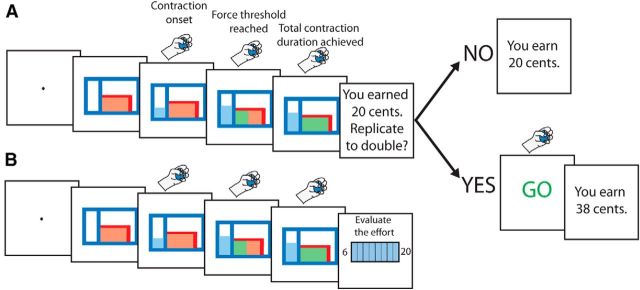Figure 1.
Schematic depiction of the task. A, The force level to be reached was indicated by the top bar of the red rectangle shown on the right of the computer screen. When the contraction was initiated, the participants were provided with a feedback about the force being applied in the form of a light blue rectangle shown on the left of the screen, whose height was proportional to the grip force. The feedback was relative to the required grip force, not to its absolute value, such that the top bar of the red rectangle was always at the same level (see Materials and Methods). As soon as the required force was reached, i.e., when the blue rectangle exceeded the top bar of the red rectangle, the red rectangle was progressively filled with green color, at a constant speed. The contraction was completed when the red rectangle was completely filled with green color, which occurred after a total contraction duration of 3 s. In 24 of 28 trials per block, after the first contraction, participants were asked whether they wanted to replicate their effort to double the amount of monetary reward received for the first contraction, which varied pseudo-randomly between trials. The second contraction was performed in the absence of visual feedback. The final reward received depended on the accuracy of the force replication (see Materials and Methods). B, In the remaining four trials of the block (one per effort intensity condition), the participants were asked to rate their subjective perception of the effort exerted during the first contraction on the Rate of Perceived Exertion Scale, which ranges from 6 to 20 (Borg, 1982).

